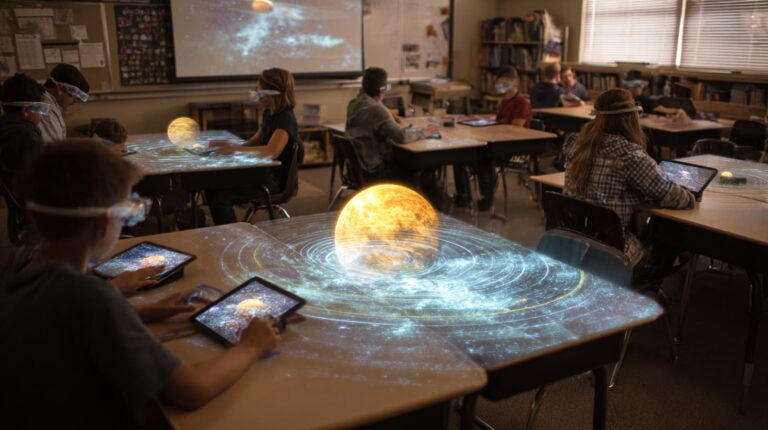
Augmented Reality: A Newbie’s Guide
The best most people know about Augmented reality is its function in the entertainment world. However, the full potential of Augmented reality isn’t as widely understood.
This review describes what Augmented reality is, the required hardware, applications, plus a few challenges to adoption worth noting. Even if you’re a complete newbie, the information in this post can help you make more effective choices on whether you want to embrace AR further or pitch your tent at a distance away from it.
What Exactly Is Augmented Reality?
Augmented Reality (AR) represents a live direct or indirect view of the brick-and-mortar world, with “augmented” or enhanced elements, thanks to computer-generated graphics, sounds, virtual objects, text graphics, and haptic feedback, superimposed over the natural human view.
It comes across as a natural part of the environment, permitting layers of interaction between these layers and the user. Blurring the line between the everyday world and the world of computer-generated content, AR has forged the long-awaited link between technology and the real world around us.
How It Works: A Briefer
Here’s a briefer on the idea of Augmented Reality for practically anyone. To grasp this idea better, could you imagine how the TV technocrats overlay titles, banners, or newsfeeds over video content streaming right before you? However, in the case of augmented reality, extra computer-generated data hosts many forms, which can be highly personalized and changed in line with the environment.
Who Can Use AR?
By creating a means of enhancing the real surroundings with computer-generated data, AR opens up an entirely new dimension of opportunities. The technology finds implementation way beyond the well-known entertainment and gaming sectors – as many people still erroneously assume.
AR finds tremendous application in fields like education, interior design, logistics, healthcare, construction, and industrial manufacturing. Practically everyone from Pokemon fans to complete novices who don’t know how to use a printer can exploit the technology in their field of vision.
Mixed Reality vs. Augmented Realty vs. Virtual Realty: The Big Question
Chances are you’ve also heard about terms like virtual reality (VR) and mixed reality, but are confused about the differences among them. Here’s a section that can clarify any doubts you might have about any of the terms.
Sometimes, people confuse AR with VR, despite having a massive difference in-between them. While augmented reality alters your field of view, virtual reality replaces your field of view with the artificial digital environment. Based on this difference, some observers think that AR is much more practical than VR.
Elsewhere, augmented reality is often referred to as “mixed reality” or “computer-meditated reality.” But that’s because the difference between these terms hasn’t been drawn enough yet, rather than an absolute oneness between them.
Where You Can Find AR
Augmented Reality finds application in various fields, ranging from interior design to games, cryptocurrency, education, and training. Let’s see various places you can find AR:
- Augmented Reality games
- AR technology
- Interior décor apps
- Virtual experiments and training sessions in educational environments
- Augmented reality books
- Augmented reality art and museums
Challenges to AR Adoption
Like many emerging technologies, adopting AR has some notable challenges. Here are some worth knowing.
- Cost: Every stage of an AR technology, from verifying a potential use case, and actual development to integration with foreign systems, is customized. Consequently, completing an AR project – or purchasing a finished product from the space – can be expensive.
- Lack of Flexibility: Suppose you need to modify or adapt an AR application to suit new devices. The process will cost a significant amount of additional funds. Meanwhile, the same use case has to be implemented from scratch for each partnership between AR hardware and software.
- Poor business development: Most developers behind AR solutions lack a holistic understanding of use cases. Consequently, they end up building a top-quality product with relatively poor business metrics.
Conclusion
Augmented reality might still be far from achieving its full potential as a 21st-century technology. But its impact has successfully cut across various sectors globally. Despite the apparent challenges surrounding the nascent technology class, AR holds a vast range of promises for the future of work, housing, governance, and entertainment.
Search
Categories
Recent Posts
Calendar
| S | M | T | W | T | F | S |
|---|---|---|---|---|---|---|
| 1 | ||||||
| 2 | 3 | 4 | 5 | 6 | 7 | 8 |
| 9 | 10 | 11 | 12 | 13 | 14 | 15 |
| 16 | 17 | 18 | 19 | 20 | 21 | 22 |
| 23 | 24 | 25 | 26 | 27 | 28 | 29 |
| 30 | ||||||